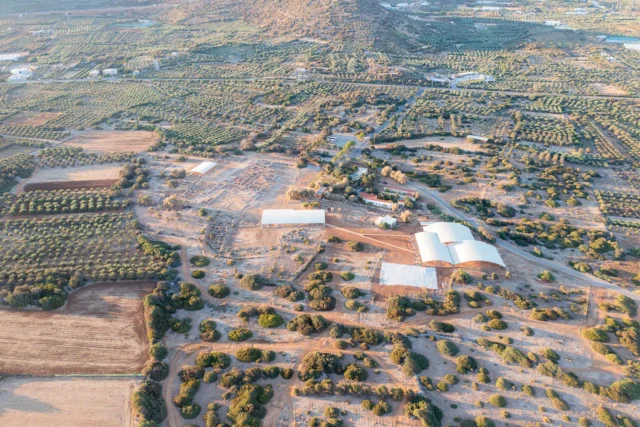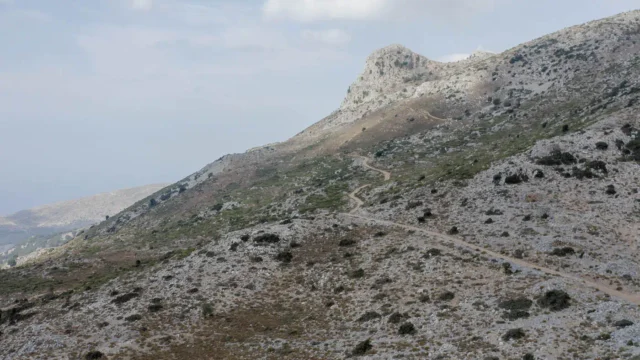Vrachasi is a traditional village in the municipality of Agios Nikolaos, Lasithi, Crete. It is located east of Heraklion and southwest of Agios Nikolaos.
The village is built amphitheatrically on the southern slope of Mount Anaύlochos at an altitude of 360 meters. Its name seems to be a derivative of the word “vrachos” (rock).
History
Due to its location, Vrachasi was often the scene of clashes between Cretan rebels and Ottoman forces during the 19th century. It is the birthplace of Konstantinos Sfakianakis, a chieftain of the 1866 revolution, and Ioannis Sfakianakis, a doctor and politician who headed the first Executive Committee of the Cretan State. In 1913, along with the rest of Crete, it joined Greece. The first census conducted by the Greek authorities in the same year found 1586 inhabitants in the village.
Administratively, it was initially under the province of Merambello as the seat of a community that also included the villages of Sisi, Epano Sisi, Kartsinianos, Pyrgos, and Agia Varvara. From 1998 to 2006, it belonged to the municipality of Neapolis.
Following residents’ reactions to the merger of local authorities under the Kapodistrias plan, with Law 3448/15-3-2006, Vrachasi (along with Zonianana Rethymno and Tsaritsani Larissa) were officially recognized as separate communities.
Since 2011, after the implementation of the “Kallikratis” Program, it has belonged to the municipality of Agios Nikolaos as the Community of Vrachasi.
Near Vrachasi are the remains of the monastery of Agios Georgios Vrahasiotis, of which only the main church survives.
Population
The population of Vrachasi has gradually declined over the years. The following table shows the population data from various censuses:
Year |
Population |
|---|---|
1913 |
1586 |
1928 |
1426 |
1940 |
1273 |
1951 |
1199 |
1961 |
999 |
1971 |
804 |
1981 |
636 |
1991 |
522 |
2001 |
382 |
2011 |
311 |
Economy
The main occupations of the residents around 1940 were agriculture and animal husbandry. Agricultural products included olive oil, almonds, carobs, and a few vegetables and fruits. Olive oil, almonds, and carobs were mainly for trade, while vegetables and fruits were for self-consumption.
Today, olive oil, vegetables (for trade), and a small amount of sultana raisins are cultivated in the area. Olive cultivation continues from the old days. The new crops started after the drilling of boreholes, about 25 years ago.
Culture and Traditions
The dialect spoken in Vrachasi is the linguistic idiom of Eastern Crete. There are seven churches within the village, the oldest of which (Agios Ioannis Chrysostomos) was built in 1587 on the ruins of an older one.
The village has a long history of community organization. During the Ottoman era, Vrachasi was the seat of a municipality, with a mayor and a municipal council. Today, it is the seat of a community.
Residents used to offer their labor without pay for community projects such as building schools, churches, and roads. Participation was compulsory for all men from the age of majority. In some cases, participation was voluntary.
Mutual aid was common among families, especially during harvest time and for building houses and fences. Women also participated in various agricultural and livestock activities.
Family and Social Life
Families in Vrachasi were typically composed of 4-5 members (father, mother, and children). Sometimes, the parents of the husband or wife lived with them. Children addressed their father as “afendis mou” or “kiris” (later “pateras”) and their mother as “ma” (later “manna”). Grandparents were called “pappous” (grandfather) and “lala” (grandmother).
The eldest brother was respected by the younger ones, and the eldest sister was expected to marry first. Uncles and aunts were addressed as “barbas” and “theia” respectively.
Most marriages took place within the village or neighboring villages. The new couple usually settled in the bride’s parents’ house, with the prospect of building their own home. The new house was considered part of the bride’s dowry.
The dowry system was prevalent in Vrachasi. It was usually agreed upon orally, but sometimes a dowry agreement was drawn up by the priest or a notary. The dowry included household items, clothing, money, a house (sometimes furnished), and sometimes land, trees, or animals.
Inheritance was usually passed down orally. All sons inherited equal shares, and daughters received a dowry or inheritance, which was usually equal to the sons’ share.
Village Key Points
- Historical References: Mentioned in historical records related to the Cretan revolts of the 19th century.
- Location: Southern slope of Mount Anaύlochos, 360 meters above sea level.
- Historical Significance: Birthplace of key figures in the Cretan revolution and a center of resistance against the Ottomans.
- Population data over the years: See table in “Population” section.
- Current Status: A traditional village with a declining population, mainly engaged in agriculture and tourism.




















There are no comments yet.